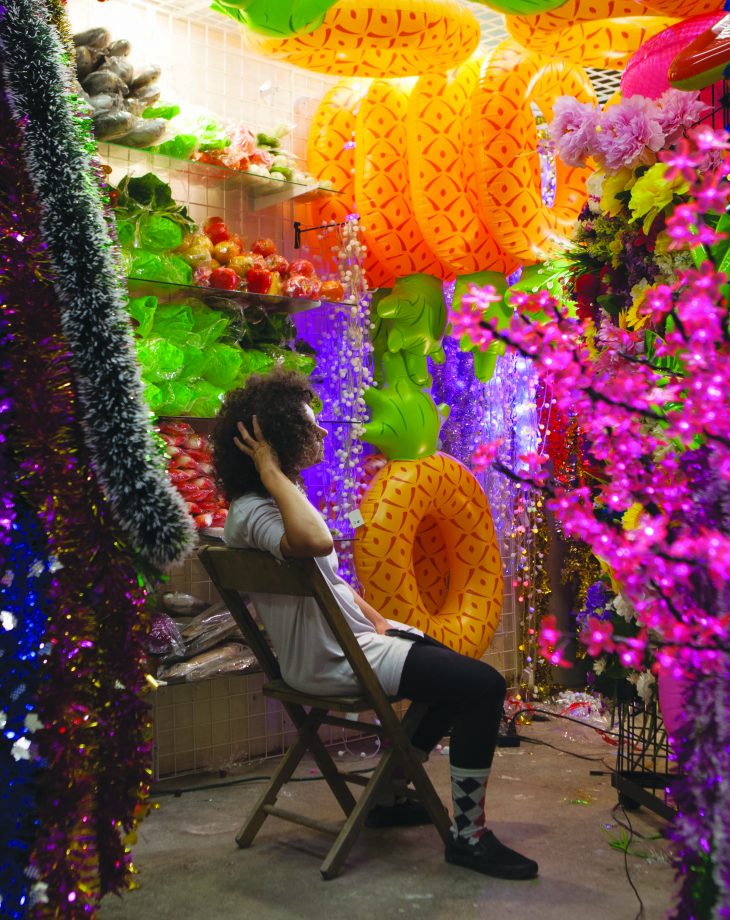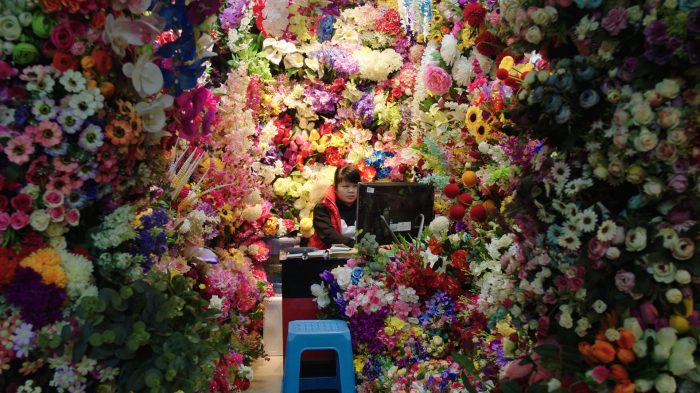
Trees surround every side of Mika Rottenberg’s studio in Tivoli, New York but inside, plastic reigns. Props from 20 years of filmmaking stuff the tall barn. On a visit in August to the artist’s live/work compound, there are boxes piled high with twinkle lights, fake flowers and inflatables. These are raw ingredients for Rottenberg’s December solo show at The Bass museum in Miami Beach.
Following on the heels of her 2016 survey at Palais de Tokyo, the new exhibition focuses on two major works from the past two years: NoNoseKnows, which the artist debuted at the 2015 Venice Biennale, and Cosmic Generator, which the artist presented this summer at Skulptur Projekte Münster. Rottenberg will create site-specific installations to house the works in the exhibition.
When I visit, Rottenberg is in the midst of creating a tunnel to accompany Cosmic Generator. The artist pays close attention to how her videos are situated; it is a habit informed by the architecture of the movie theater—the often spectacular sequence of rooms that carry the audience from the street to the screen. “These spaces always feel magical, fantastical,” Rottenberg says, leading me into her LED-lit portal. “The carpet is always very bright… the popcorn machine. This in between space prepares you. I remember growing up going to this movie theater where you went straight from your seat to the sidewalk. It was such a harsh transition to leave this fantasy space and confront reality. Psychologically too, it’s important to create this in-between state or operation.”

Enveloped on all sides by twinkling strands, I confess to Rottenberg that I feel claustrophobic. She tells me that this is the desired effect. “The portals create a kind of physical curiosity,” she confine you in a way and make you walk in a certain way. You are made aware of your own body in space and how you are being manipulated.” Once beyond Rottenberg’s jungle of plastic foods and LED light strands, audiences will encounter her largest screen to date, a 16-foot projection, but for now it’s just a barn door. “I feel like with every piece I grow a foot or two,” she jokes. “I’ve always liked the idea of being trapped in the work, being led into a smaller and smaller space. And suddenly I’m turning 40, and I thought maybe I could get rid of the ceiling and just expand.”
The increasing scale of her projections correlates with their runtime. Early works like Cheese (2008) and Tropical Breeze (2004) screened in under 10 minutes. “In length, I’ve been growing by five or so minutes every piece,” Rottenberg says of the progression. “I know some artists would have no problem making an hour-long video that is 40 feet long, but with the way I work every second has to matter, has to be packed with as much as possible.”
The artist is not being hyperbolic; the world she occupies is one of complete saturation. Her films are jam-packed with characters, props and production. In NoNoseKnows, viewers follow the life of an unnamed woman who works at a factory, where she sniffs flowers and sneezes plated pasta dishes out of an ever-expanding nose. Beneath her feet, female pearl cultivators introduce cannibalistic irritants into oysters. A circle of rope and a pair of feet connect the two floors, but the nature of their relationship is never completely illuminated.

While NoNoseKnows includes coherent stretches of narrative and documentary footage, the entire film may be best understood as a sculpture rather than a story. “The narrative has a physical shape,” Rottenberg explains. “I say shape because it’s more like a map than a sequence of images. The work moves through space rather than time.” Time becomes a gestural medium that Rottenberg uses to reveal reality’s dynamic form.
In the case of Cosmic Generator, Rottenberg seeks to give a physical body to discussions surrounding borders and the exchange of culture across them. Rottenberg addresses the issue by creating a network of fictional tunnels that knit together China, Mexico and the U.S..
I spy sections of tunnels in halves on Rottenberg’s back porch. Like past projects, the artist filmed certain scenes here and others on the road. For Cosmic Generator, Rottenberg traveled to the Yiwu Market in Zhejiang, China and then to the Mexicali border, where she filmed in several Chinese-owned businesses as well as . Rottenberg’s location choices seem to address areas that were of early interest to the then-presidential candidate Donald Trump, but the artist tells me that the connection is actually just coincidental, spookily so.
When Rottenberg and her film crew first landed in China, they arrived to the news that Trump had won and that the incumbent’s first missives played on a trade war. The artist’s subject matter—Yiwu, the 1,000,000-square-foot market responsible for the international dissemination of every conceivable type of plastic bobble—suddenly felt like the center of the universe. “It was bizarre to be where the news was without really meaning to,” Rottenberg says. “I don’t think it affected the film on a basic level, but I did feel like I was tapping into something.”

This feeling only intensified when, months later, Rottenberg landed in Mexico to learn that Trump was using his inauguration speech to highlight his plans for a border wall—which, like Rottenberg’s tunnels, remains largely fictitious. “I think a lot about globalization, cultural homogenization, diversity and borders,” the artist says. “These themes aren’t accidentally in the work.”
When it comes to resolutions, one would be hard pressed to find them in Cosmic Generator. The artist maintains a veil of plausible deniability in an almost absurdist way. Her characters never evolve, her plots never climax; instead, the viewer is left with a form that is able to hold the paradoxes of a globalized market, its empowerment and toxicity. “I think Cosmic Generator is actually the most optimistic piece I’ve made,” Rottenberg confesses. “It’s not anti-trade necessarily, or anti-China or anti-globalization. It’s about the movement of energies and objects in the world and the power systems that control them. Of course I think about these things all of the time, but I haven’t drawn any conclusions yet. It’s not a judgement, it’s a study.” Contrasted against today’s didactic politics, Rottenberg’s work feels like a step towards healing.










 in your life?
in your life?

